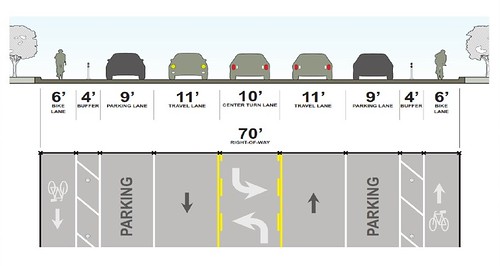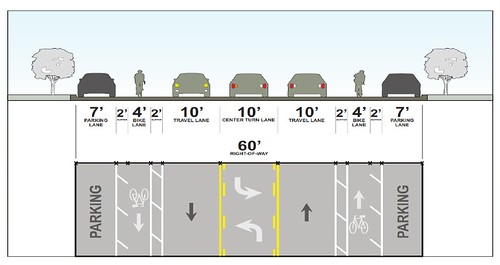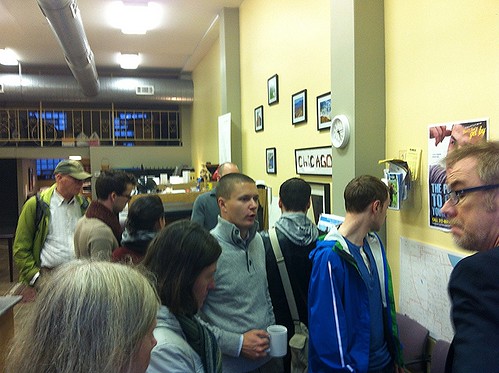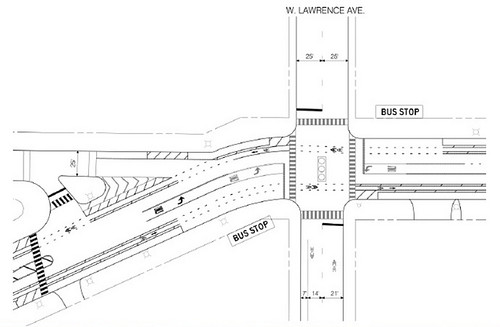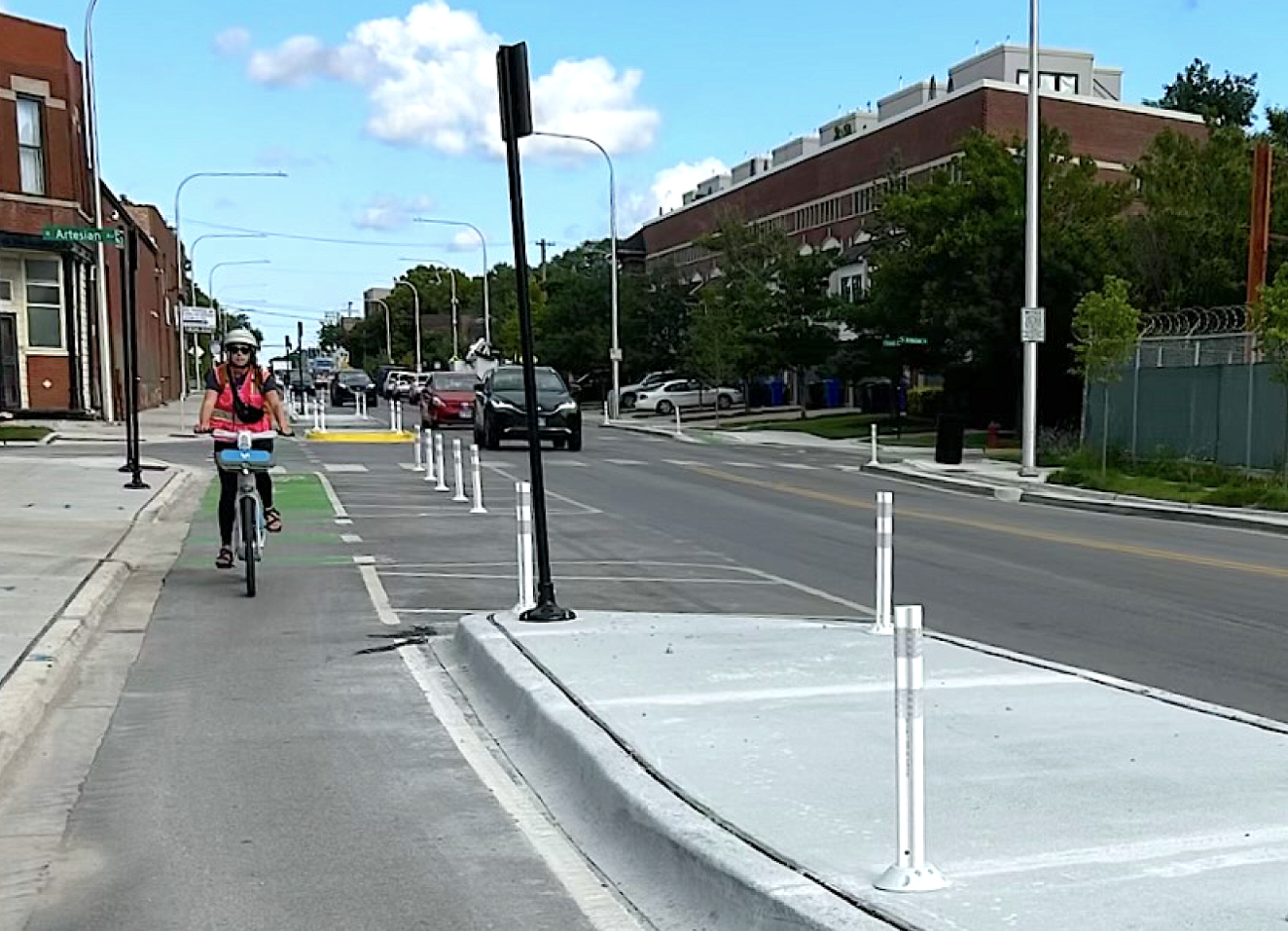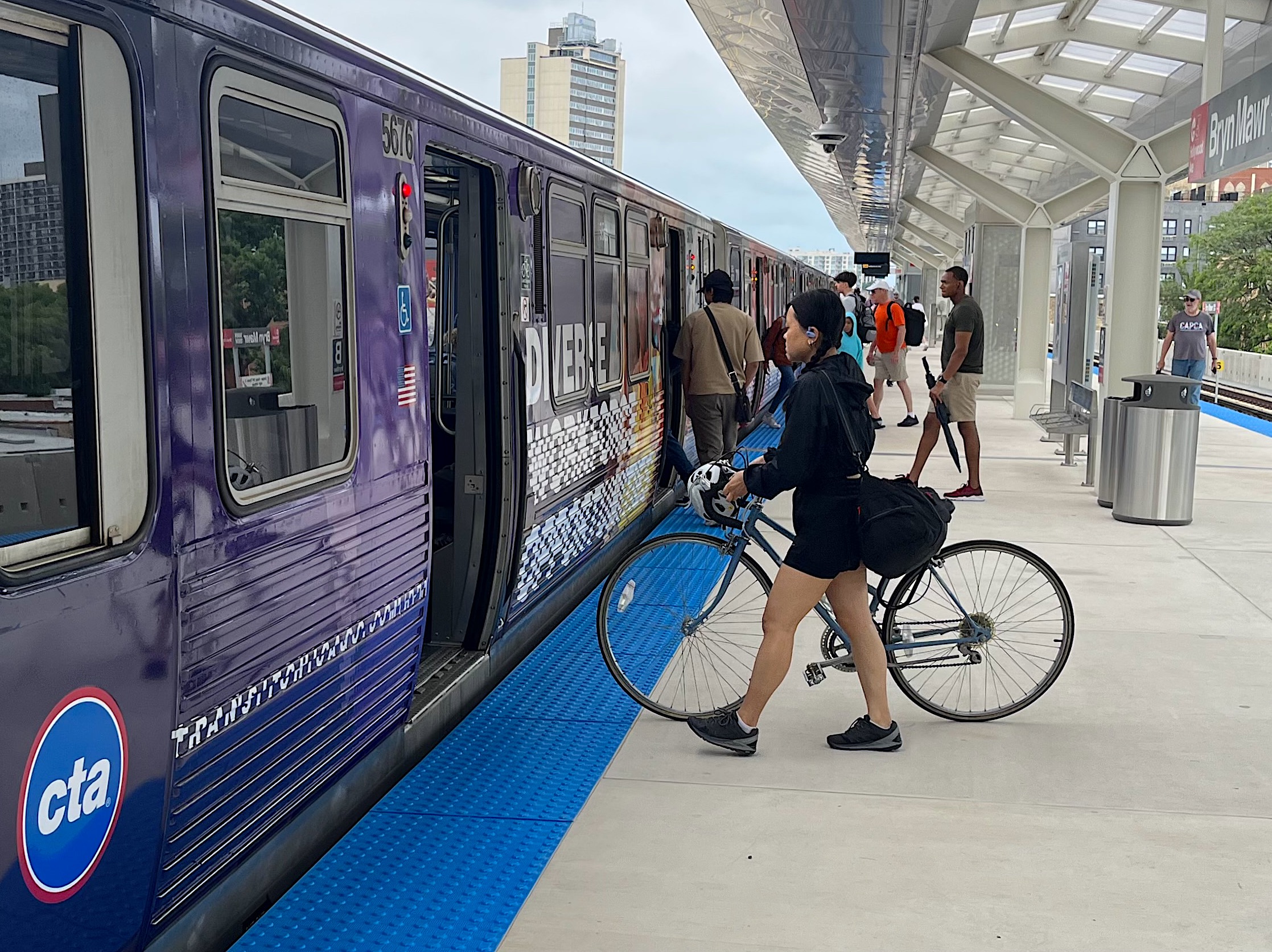Uptown is one of Chicago’s few bike-friendly neighborhoods that doesn’t have any conventional bike lanes, let alone buffered or protected lanes, but that will change by the end of the year with an upcoming Chicago Department of Transportation project.
Broadway between Montrose and Foster will get protected bike lanes for two blocks from Montrose to Wilson, and buffered bike lanes from Wilson to Foster. This section of Broadway is designated as a crosstown bike route in CDOT’s Streets for Cycling 2020 Plan. The southern stretch will be one of the few PBL streets in town that also features plenty of pedestrian-oriented retail – hopefully this combination will become more common in the future.
In addition to the new bike lanes, the entire 1.05-mile section will undergo a road diet, transforming the wide, four-lane street into two through lanes and a center turn lane. 16 existing metered parking spaces will be eliminated to improve sight lines at intersections. In compliance with the city’s parking contract, 12 new metered spots will be created elsewhere on Broadway, and the other four will be added on nearby streets within the 46th Ward.
The case for the road diet is strong. On average, Broadway carries 11,000 to 13,000 vehicles daily. Even though the new configuration reduces the number of travel lanes, it can accommodate as many as 20,000 car trips per day, according to CDOT. The new center turn lane will reduce traffic back-ups and swerving caused by left-turning motorists.
Even without bike lanes, recent CDOT bike counts at Broadway at Wilson recorded over 150 cyclists during a 4-hour period. The proximity of this section of Broadway to four Red Line stations, several bus lines, and many retailers also generates plenty of foot traffic. With the road diet, pedestrians will have fewer lanes of moving car traffic to cross, and there will be new, high-visibility zebra-striped crosswalks.
The plan resembles most other protected bike lane projects CDOT has implemented, which have a few shortcomings, mainly due to budget limitations. At the meeting, I suggested that leading pedestrian interval walk signals should be implemented if possible, and that cyclists be given legal permission to use the walk signal as their green light so as to make themselves visible to turning drivers. If this isn’t feasible for the Broadway, LPIs would be a useful addition to future projects.
Bus stops on Broadway will be located in “mixing zones” with cyclists. Therefore, when buses stop to load and unload passengers, cyclists will have to ride to the left of the bus, or wait behind it. On PBLs like the one on Dearborn, green paint has been added at conflict points to alert drivers to the presence of the bike lanes but, due to fiscal restraints, there are no plans for this on Broadway.
Finally, there will be no dedicated left turn facilities for bicyclists. It’s up to cyclists to determine how to best execute a left turn from the protected lane. Dearborn features left-turn boxes for bikes.
At the meeting, a CDOT staffer said feedback from community members on the project has been mostly positive. One attendee stated that he was not anti-bike, but asked why the city is “catering to cyclists while diminishing car capacity,” noting that while Chicago drivers need to buy an annual city registration sticker, cyclists don’t have to pay an analogous fee. However, Broadway currently has excess car capacity, which encourages speeding. After the reconfiguration it will still have more than enough capacity, but traffic will be calmed.
The $200,000 project is an investment in the community. Not only do calmer streets with accommodations for all users have the potential to create more vibrant neighborhoods, they also reduce the rate of crashes and injuries. For example, since a protected bike lane was installed on 9th Avenue in Manhattan, the street has seen a 56-percent reduction in injuries to all street users.
Between 2006 and 2010, there were 909 crashes in the Broadway project area, 113 of which resulted in injury. On average, each injury crash costs the city $53,000, so a safer street will lead to significant savings for taxpayers.
The new bike infrastructure will link to several existing and future bikeways. The Leland Greenway, a project elected by residents during last year’s 46th Ward participatory budgeting process, will be installed from Clark to Clarendon, intersecting with this stretch of Broadway.
The northern terminus of the Broadway bike lanes is located just west of Winthrop, a southbound recommended route on the city’s bike map, and Kenmore, a northbound recommended route. However, the connection from Broadway to these streets via Foster is not currently signed, and no signs are planned. A block north of Foster, Berwyn is a recommended westbound route from Broadway.
View Uptown bikeways in a larger map
Buffered section of Broadway (blue), protected section (green), Leland Greenway route (orange), sharrow streets (magenta), and recommended routes (yellow)
At the southern terminus of the new bike lanes, the large and confusing Broadway/Montrose/Sheridan intersection may be intimidating to inexperienced cyclists, and there won’t be any wayfinding signs to guide them onto other bike-friendly streets. However, the intersection is slated to be reconfigured in the future to be safer and more inviting. The leg of Sheridan through the intersection will be closed to create a new pedestrian space called SherMon Plaza, another project selected in the participatory budgeting process.
There is currently no plan to extend the Broadway bike lanes southeast .8 miles to connect with existing conventional bike lanes on Halsted. In the meantime, a bike-friendly way to make the connection is to ride two blocks east on Montrose to Clarendon, which has sharrows and light traffic – only 4,700 cars daily. From there one can pedal a half mile south to the Halsted lanes.
The Broadway is being bankrolled with $155,000 in menu money from the 46th ward, and $45,000 in CDOT funds. Next week, the transportation department will do patch resurfacing, and striping will begin shortly afterwards, provided that the weather is conducive. At 50 degrees pavement is still warm enough for laying thermoplastic paint, but markings applied at lower temperatures soon peel off the asphalt. CDOT learned that lesson the hard way after bikeways installed last year on Desplaines and Division in too-cold weather quickly degraded.
